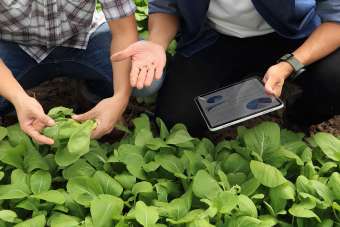Added: Over a year ago by Ipsos Jarmany
You might be surprised to hear that the world’s first underground farm is located 33 metres below Clapham High Street. Founded in 2015, a former World War Two bunker is now home to Growing Underground, farming a variety of microgreens and herbs with the aim of producing zero-carbon food.

To help achieve this, the farm has a digital twin based at the University of Cambridge. The farm utilises 25 sensors to measure every element of the farming process, including humidity, nutrients, and water levels. This is used to create a virtual representation of the farm, which monitors the crop growth and provides feedback. The environment can then be tweaked to create the optimal growing conditions.
This impressive operation uses 100% renewable energy, requires less space than traditional farming and has no need for pesticides. It’s also had impressive results:
The produce is then taken to New Covent Garden Market for distribution across the capital (including London Marks & Spencer food halls), helping to reduce food miles.
What is precision farming and how does it work?
While Growing Underground is the first underground farm, the use of data in agriculture is rapidly developing into the Third Green Revolution. Known as precision agriculture or smart farming, data and technology has the potential to help solve the problem of feeding the growing population by enabling farmers to grow more efficiently.
Environmental sensors installed in the fields record climatic information and soil requirements across large areas of land. Combined with satellite images captured by agricultural drones, interactive maps capture the health state of the field. This means anomalies and issues such as nutritional deficiencies, irrigation issues and localised parasitic attacks can be identified and solved with targeted actions.
Precision farming can also extend to livestock farming, allowing farmers to monitor the needs of individual animals and adjust their diet, which in turn helps to prevent disease. They are also able to identify and isolate sick animals.
What are the benefits of precision farming?
Given the exponential increase in population, the number of people estimated to require food in 2050 is 9 billion. Precision agriculture has the potential to help achieve this by minimising the exploitation of water and fertiliser resources without compromising the physical and chemical quality of the soil. This contributes towards the movement to a sustainable food production model, as well as being financially beneficial for farmers whose yields and productivity are boosted.
Currently, only a small percentage of farmers invest in any form of precision agriculture as educational and economic challenges remain a barrier to expansion. Not only does it require a significant initial investment, making it largely unattainable; it also requires farmers to understand and analyse their data and findings, meaning there is a long way to go before precision agriculture is scaled up across the world.
Growing Underground conduct this research with the University of Cambridge and the Alan Turing Institute, who focus on Data Science for Social Good. Their aim is to help not-for-profit organisations and governments make the best use of their data in science. This enables them to improve their services and interventions to eventually improve lives.
Recognising the power of data science in development and solving global challenges across education, health, energy, public safety, transportation and economic development, the Alan Turing Institute work on solving real world problems. For example, working with Ofsted to improve the quality of care and education, and with the World Bank to identify and analyse corruption risks in public administration. Additionally, work aimed to “supercharge” the Sustainable Development Goals through simulating the impacts of government spending has the potential to change and save lives as countries adopting the methodology move closer to achieving these goals.
The research carried out by the Alan Turing Institute acts as an important reminder of the potential and power of data in solving global issues. Given the increase in advanced data collection and analysis methods, there is increased capacity for NGOs and governments to collaborate to find solutions to the environmental and societal challenges of today and tomorrow.